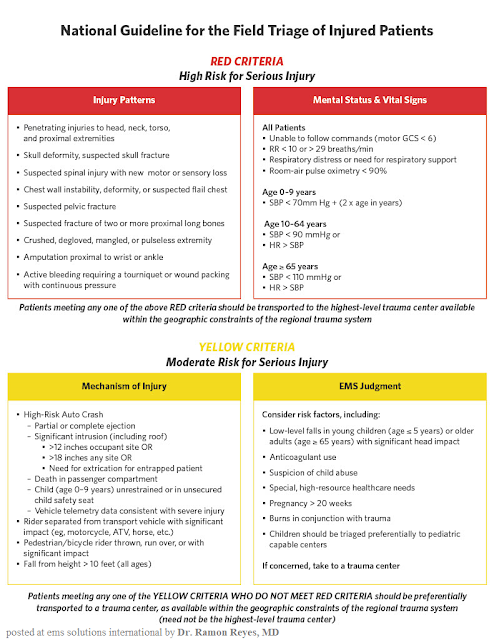Es oficial, PHTLS y ATLS asumen este algoritmo de Triage Prehospitalario simplificado con solo dos colores, Amarillo (no grave) Rojo Grave, Negro (nada que hacer) Verde que se siente y tome agua en lo que trabajamos con los que nos necesitan.. .Traducción
It's official, PHTLS and ATLS assume this simplified Prehospital Triage algorithm with only two colors, Yellow (not serious) Red Serious, Black (nothing to do) Green to sit down and drink water while we work with those who need us.. . Translation
Dr. Ramon Reyes, MD jijij TRAUMA SYSTEMS National Guidelines for the Field Triage of Injured Patients by Amercan College of Surgeons ACS. 2021
https://www.facs.org/quality-programs/trauma/systems/field-triage-guidelines/
Resources
The ACS, in collaboration with partner organizations, has developed a series of resources and implementation tools for use by providers and EMS and trauma system leadership.
The following manuscripts have been published describing the evidence and process for revision of the Guidelines.
- The National Trauma Triage Protocol: How EMS Perspective Can Inform the Guideline Revision
- Under-Triage and Over-Triage Using the Field Triage Guidelines for Injured Patients: A Systematic Review
- National Guideline for the Field Triage of Injured Patients: Recommendations of the National Expert Panel on Field Triage, 2021
- Mechanism of Injury and Special Considerations as Predictive of Serious Injury: A Systematic Review
Additional resources:
Contact Information
If you have any questions, please contact traumasystems@facs.org.
The 2021 National Guidelines for the Field Triage of Injured Patients or “Guidelines” are now available. A multidisciplinary expert panel led by the American College of Surgeons (ACS) undertook this revision with support from the National Highway Traffic Safety Administration (NHTSA), the Health Resources and Services Administration’s (HRSA) Maternal and Child Health Bureau, and EMS for Children Program.
For three decades, the Guidelines have been widely adopted by trauma systems in the United States to support decision making by EMS clinicians in transport destination determinations for injured patients. The goal has been to ensure that seriously injured patients are transported to the most clinically appropriate trauma centers.
The 2021 revision was based on a scientific literature review conducted by Oregon Health and Science University as well as the results from a broad stakeholder feedback tool, which aimed to capture the perspective from those in the field.
National Guideline for the Field Triage of Injured Patients: Recommendations of the National Expert Panel on Field Triage, 2021
Journal of Trauma Surgery
Training Materials
In parallel with the revision of the National Guideline for the Field Triage of Injured Patients, training materials have been developed for use in teaching field triage to new and practicing EMS professionals. Two slide sets are available: one which provides an overview of the 2021 Guideline and is intended for educators to use for the didactic portion of instruction and one that offers customizable case-based triage scenarios for discussion.
Manuscript
It is encouraged that EMS educators read the source manuscript to fully understand the Guideline and rationale for the included criteria and structure. The Guideline is intended for patient destination decision in the field, not mass casualty incidents (MCI) or trauma team activation at a receiving trauma center.
Slide Sets
The didactic portion of instruction covers the current version of the Guideline, highlights changes from the past 2011 version, as well as the rationale for the changes made. Educators should review these slides with students first before moving into the case-based scenarios. The presentation can be customized for the local trauma system and its resources and protocols by modifying the indicated slides.
Case-based triage scenarios were developed to demonstrate application of the Guideline. The slides are designed for use following the didactic portion of instruction. There are 6 total cases, some with multiple versions. Depending on time constraints, it is suggested that educators select 3-5 cases to review. Each case includes several discussion points, including the criterion demonstrated, system and resource considerations, bypass of other centers, ultimate patient destination, and transport mode considerations. There are notes for the presenter on each slide to guide the discussion. The cases have been developed in two versions.
The first version is intended for experienced EMS clinicians practicing within an established trauma system to maximize the practical application of the National Trauma Field Triage Guideline. This slide set emphasizes a discussion framing triage decision making within the context of the local EMS and trauma system in which the students practice. Two versions of these slides are available based on either an ABCD or MARCH primary survey to align with updated initial assessment in Version 2 of the NASEMSO Model EMS Clinical Guidelines. Select the version with the primary survey approach used by the students.
The second version is intended to be used primarily with new EMS students to help them gain an understanding of how system resources may impact their decision making. This set of slides includes a mix of urban, suburban, and rural settings with hypothetical trauma and EMS system resources for students to consider when making triage decisions. Two versions of these slides are available based on either an ABCD or MARCH primary survey. Select the version with the primary survey approach used by the students.
Por favor compartir nuestras REDES SOCIALES @DrRamonReyesMD, así podremos llegar a mas personas y estos se beneficiarán de la disponibilidad de estos documentos, pdf, e-book, gratuitos y legales..
Grupo Biblioteca/PDFs gratis en Facebook
https://www.facebook.com/groups/PDFgratisMedicina #DrRamonReyesMD
https://www.facebook.com/DrRamonReyesMD
https://www.instagram.com/drramonreyesmd/
https://www.pinterest.es/DrRamonReyesMD/
https://www.linkedin.com/in/drramonreyes/
https://twitter.com/eeiispain
Blog
http://emssolutionsint.blogspot.com/2016/12/dr-ramon-reyes-diaz-md-emt-t-dmo.html
TELEGRAM
Group https://t.me/joinchat/GRsTvEHYjNLP8yc6gPXQ9Q











No comments:
Post a Comment